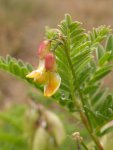Astragalus - astragalus
Family Legumes - Fabaceae (Leguminosae)
Botanical characteristics. One- or perennial herbaceous plant, shrub or half-shrub with erect stems of 40-60 cm in height. Leaves are complex, odd-pinnate, on one side, or only on the lower side of the paleus. Flowers and inflorescences vary in shape and color, depending on the species. Fruit is a bean. Blooms from June to August. Fruits until late autumn.
There are several species. The most common and curative are:
- Astragalus of Dahur - Astragalus dahuricus Pall. One- or two-year-old plant. It grows on dry meadow floodplain meadows, in steppes, on deposits, sometimes undergrowth. The root is vertical. The stem is straight. Leaflets 5-9-paired oblong-oval, pubescent with hairs. Inflorescence ovate, at the beginning of flowering compact, later highly elongated. Corolla blue-violet. Bob is slightly curved, trihedral.
- Astragalus povislovetkovy - Astragalus penduliflorus L. An annual herb with a small vertical root. It occurs on the slopes, along the banks of rivers, in bushes. The stalk is loose. Leaflets are pale green, at the apex dull or pointed. The flowers are yellow, sometimes reddish with black hairs on the calyx teeth. Beans are black-haired.
- Astragalus of Danish - Astragalus danicus Rupr. Perennial herbaceous plant up to 45 cm tall. It grows in meadows, glades, stony slopes. Rhizome thin, stem rising or prostrate. Leaves 6-13-paired, on both sides scattered-hairy. Flowers are blue-violet in dense short brushes. Legumes sessile pubescent.
All species have medicinal properties, for therapeutic purposes can be used similarly. Medicinal raw materials are the roots and the aerial part of the plant, collected in the usual way.
Used parts of the plant. All parts of the plant contain coumarins, saponins, alkaloids, tannins, flavonoids, in addition, the roots contain carbohydrates and related compounds - astragalans. In leaves and flowers - vitamins, essential oil. Seeds contain fatty oil.
Application. In folk medicine, the aerial part of the plant in the form of infusions and decoctions is used as a choleretic, in diabetes mellitus, hypertension, headache, flu, as a restorative, diuretic, with tuberculosis, cardiovascular diseases, stomach, spleen, metabolic disorders.
In scientific medicine, some types of astragalus are used for hypertension complicated by coronary insufficiency, with acute and chronic nephritis.
In the experiment, astragalus preparations show high antitumor activity, increase blood formation, have an antibacterial effect on gram-positive bacteria, streptococci, diphtheria rods; Strengthen the walls of capillaries, normalize pathological changes when exposed to x-ray irradiation in large doses; Have a pronounced vasodilator, hypotensive, immunostimulating, calming nervous system action.
In Chinese, Tibetan and Mongolian medicine, astragalus is used in the treatment of malignant tumors, cardiovascular diseases, as a means of stimulating hematopoiesis, diabetes mellitus, metabolic disorders, impotence, as a tonic, increasing physical efficiency, leprosy, pyoderma, various gynecological diseases, Stroke on the basis of atherosclerosis, with edema, diseases of the spleen, gastric emptying and other organs.
Preparation
- For infusion take 20 g aboveground part, pour 200 ml of boiling water, insist on a water bath for 15 minutes, cool 45 minutes, filter, bring up to 200 ml. Take 1/3 cup 3 times a day.
- For broth take 15 g of crushed roots, pour boiling water 200 ml, insist 30 minutes in a boiling water bath, cool 10 minutes, filter. Take 2 tbsp. Spoon 3 times a day after meals.
see also





Comments
When commenting on, remember that the content and tone of your message can hurt the feelings of real people, show respect and tolerance to your interlocutors even if you do not share their opinion, your behavior in the conditions of freedom of expression and anonymity provided by the Internet, changes Not only virtual, but also the real world. All comments are hidden from the index, spam is controlled.